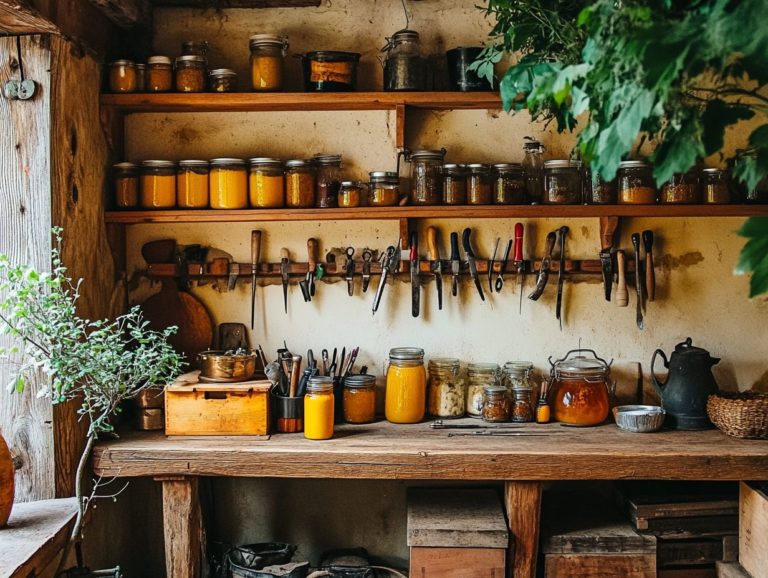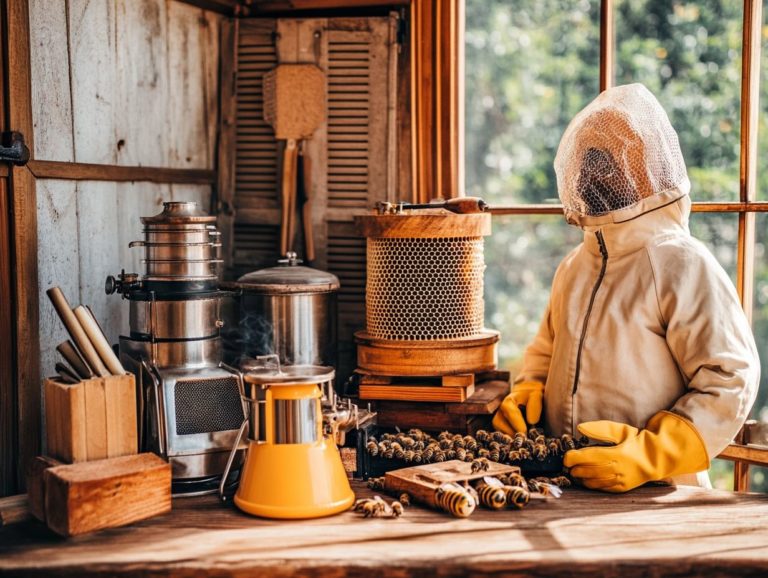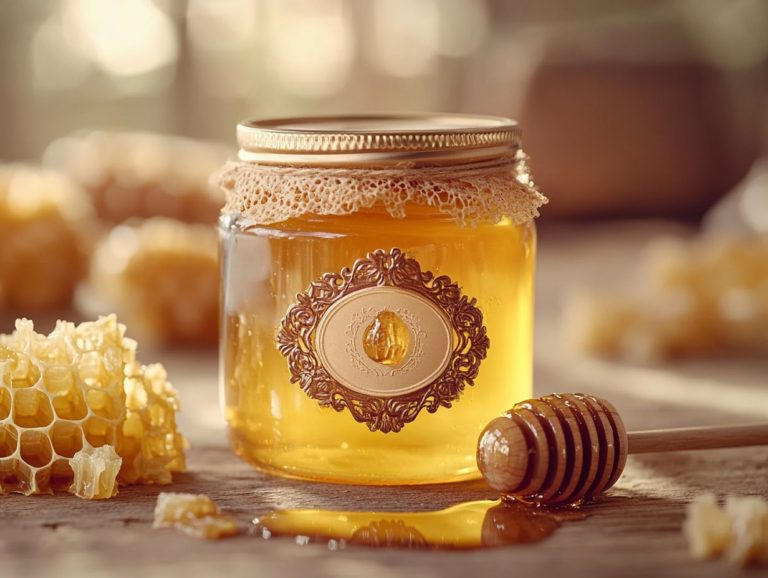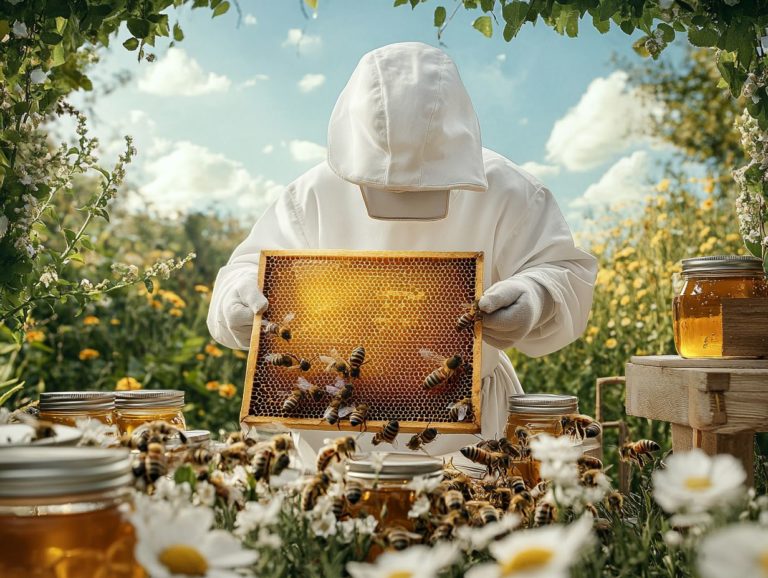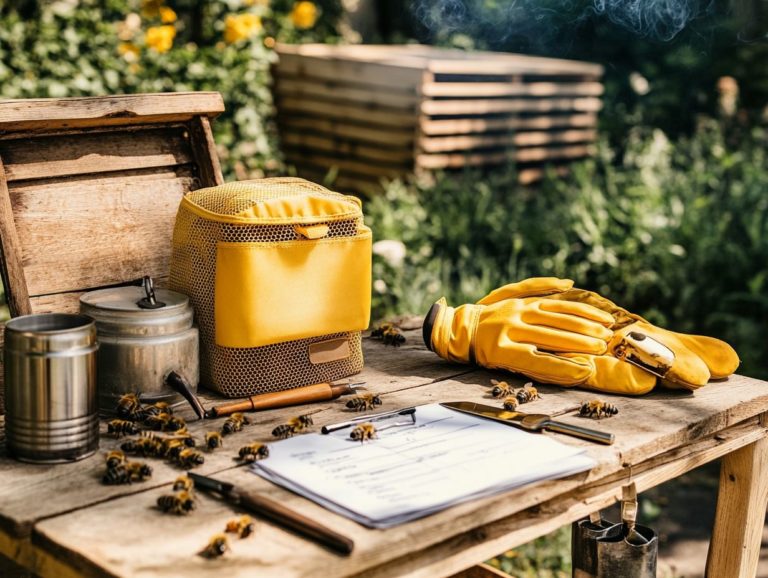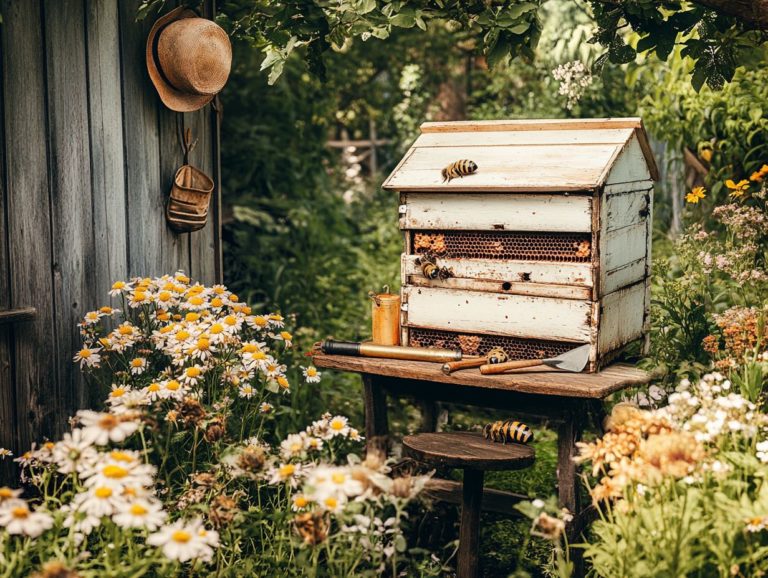How to Identify Quality Beekeeping Supplies
Beekeeping is a truly rewarding venture that demands the right tools to ensure the health of your honey bees and the success of your hive. Whether you are just starting out or have years of experience as a beekeeper, grasping the essential beekeeping supplies is critical for effective management.
From beekeeping basics to advanced techniques, understanding these essentials is key. From beehives and protective gear to honey extractors and feeding equipment, every item you choose makes a difference in your beekeeping success. This guide will walk you through the must-have supplies, provide insights on selecting quality products, and point you to where you can find them, ultimately empowering you to establish a thriving beekeeping operation. Whether you’re using vertical hives or horizontal hive setups, having the right bee equipment is crucial.
Contents
- Key Takeaways:
- What are the Essential Beekeeping Supplies?
- How to Choose Quality Beekeeping Supplies?
- Where to Buy Quality Beekeeping Supplies?
- Frequently Asked Questions
- Wondering what to look for in quality beekeeping supplies?
- How can I tell if a beekeeping supply is made with high-quality materials?
- Are there any certifications or approvals I should look for in beekeeping supplies?
- Is it important to buy beekeeping supplies from a reputable supplier?
- What are some warning signs of low-quality beekeeping supplies?
- Can I Save Money by Purchasing Lower-Quality Beekeeping Supplies?
Key Takeaways:
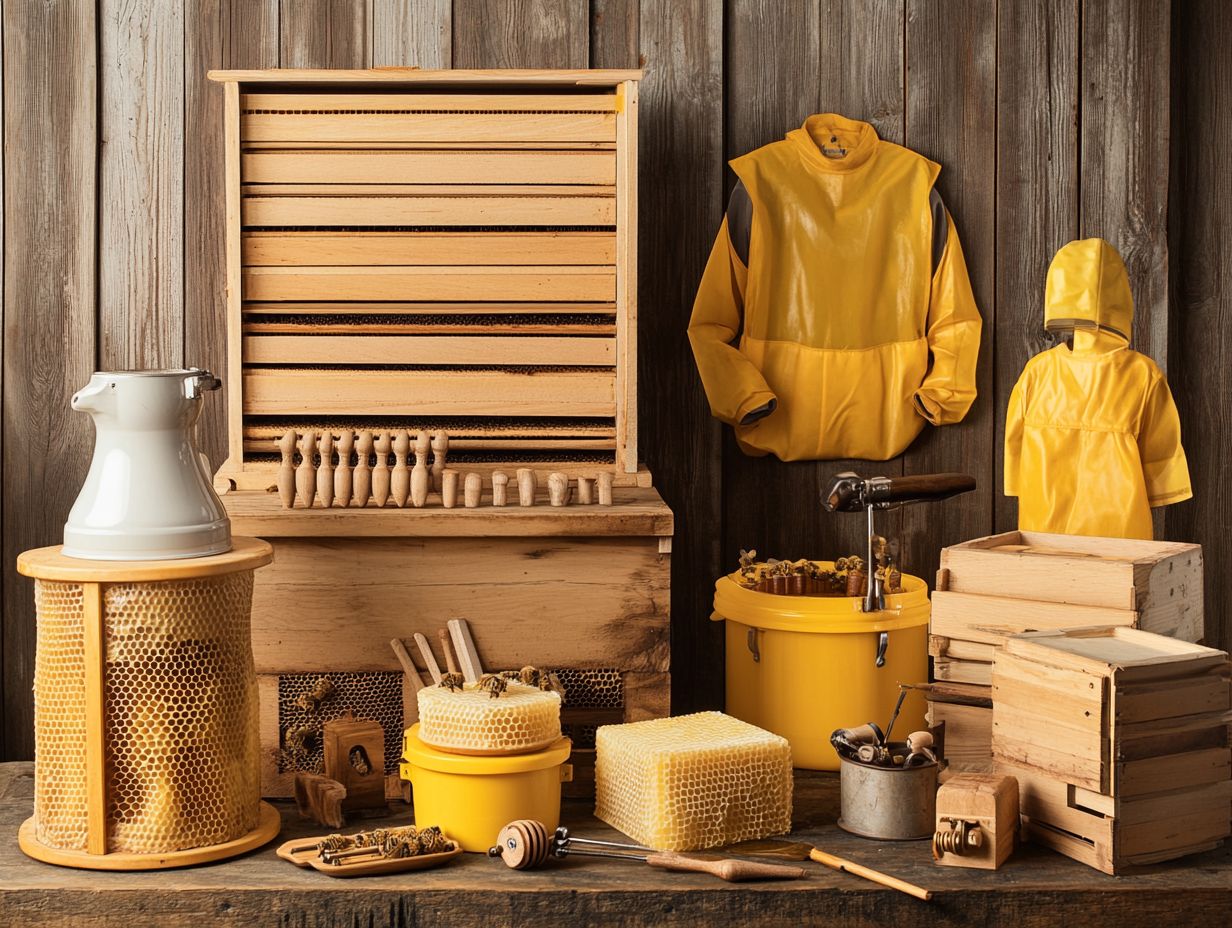
- Look for quality materials, durable and functional beekeeping supplies to ensure long-lasting and efficient use.
- Consider brand reputation and cost-effectiveness when choosing beekeeping supplies to find the best value for your money.
- Local beekeeping stores, online retailers, and beekeeping associations are great places to find and purchase quality beekeeping supplies. Don’t forget to check out resources like beekeeping books and beekeeper education programs to enhance your knowledge.
What are the Essential Beekeeping Supplies?
Embarking on your beekeeping journey requires a thoughtful selection of beekeeping supplies, which are crucial for ensuring the health and productivity of your honey bees. Whether you’re just starting out or you ve honed your skills over the years, grasping the essentials will significantly elevate your success in managing your beekeeping.
Consider resources like Bee Kept Bootcamp or the School of Traditional Skills to sharpen your beekeeping techniques. From deciding between vertical hives and horizontal setups to mastering the intricacies of hive inspection procedures, every component is vital in the art of bee maintenance and honey production.
Essential tools like Langstroth frames and Layens frames are critical for establishing a thriving bee colony, while other foundational supplies such as hive tools, bee brushes, and smokers lay the groundwork for sustainable beekeeping practices.
1. Beehive
A beehive serves as the essential habitat where your honey bees thrive and perform their tasks. Choosing between vertical and horizontal hive designs ultimately hinges on your personal preferences and the space you have at your disposal. Ensuring the right bee habitat is critical for effective beekeeping.
In the realm of beekeeping, you’ll find various hive types, like the Langstroth and Layens, tailored to meet diverse beekeeper needs and accommodate different bee behaviors. The Langstroth hive, renowned for its stackable boxes and removable frames, simplifies management and honey extraction. Its vertical design maximizes space efficiency, though it may require a bit more lifting on your part. Incorporating essentials like the queen excluder can further optimize your hive’s productivity.
On the other hand, the Layens hive boasts a horizontal layout that tends to be more comfortable to work with, reducing strain during frame inspections. This design often enhances ventilation and can promote more natural bee behavior, potentially boosting nectar production. For those interested in natural methods, the Layens hive is an excellent choice.
By understanding these characteristics, you’ll be better equipped to select the hive that aligns perfectly with your beekeeping aspirations.
2. Beekeeping Suit
Every beekeeper needs a reliable beekeeping suit! It’s your first line of defense against stings and discomfort. A beekeeping suit is a critical piece of protective gear for you as a beekeeper, offering a perfect blend of safety and comfort while you work around honey bees and their hives. Investing in high-quality protective clothing is a must for every beekeeper.
These suits are crafted with lightweight, breathable fabrics that help regulate temperature and moisture. This ensures you remain comfortable during labor-intensive tasks like hive inspections and honey harvesting.
The material is often treated to repel stings and safeguard against pests, making it an essential tool in your beekeeping arsenal. You ll find that the design typically includes a ventilated hood and gloves, which are critical for protecting your more vulnerable areas.
By investing in a high-quality bee suit, you can significantly minimize the risk of bee stings, allowing you to concentrate on your work without the nagging worry of potential hazards.
3. Bee Smoker
Every beekeeper must have a bee smoker! This incredible tool helps manage your honey bees safely and efficiently during inspections. Understanding the proper use of smokers can greatly improve your hive management techniques.
This clever device generates cool smoke that has a calming effect on the bees. It keeps their aggression at bay while you navigate hive management. By introducing this gentle smoke, you can approach your hives with newfound confidence, significantly reducing the chances of stings and promoting both the welfare of the bees and the effectiveness of your inspections.
You can experiment with various fuel types in the smoker think pine needles, dried leaves, or even specialized smoker pellets. Each of these options produces unique forms of smoke, adding a layer of versatility to your beekeeping routine.
When used correctly, a bee smoker not only enhances the safety of your bees but also enables you to conduct thorough inspections with minimal disruption to the colony. This is especially important when dealing with feral bees or during a bee swarm.
4. Hive Tool
Don’t head to the hive without your hive tool! It’s crucial for seamless inspections and maintenance. A hive tool is an important instrument that you, as a beekeeper, should always have on hand. It’s your trusty sidekick for opening hives, scraping frames, and tackling various maintenance tasks with ease. This essential tool is indispensable for effective apiary management.
This critical tool features a flat blade, perfectly designed to pry apart hive boxes effortlessly. Its forked end is ideal for removing frames or scraping away propolis a sticky substance bees use to seal their hives from surfaces, making your work smoother and more efficient.
Many beekeepers use a smoker with the hive tool to create a calm atmosphere; the gentle presence of smoke soothes the bees, ensuring that inspections are not only safer but also more effective. Specialized tools like the J-hook hive tool can further streamline your inspections.
You may also consider specialized hive tools, such as the J-hook hive tool, which offers enhanced leverage and functionality. These tools play a crucial role in facilitating swift inspections, allowing you to make more accurate assessments of your colony s health and productivity. Ultimately, this enhances your apiary management, ensuring your beekeeping endeavors flourish.
5. Bee Brush
A bee brush is your gentle ally, designed to safely remove honey bees from frames during hive inspections without causing harm. This ensures the well-being of the bees while allowing for effective hive management.
This tool is essential during the honey harvest, enabling you to carefully displace bees from honey-laden frames with minimal disruption. With a soft bristle brush in hand, you can gently nudge the bees away, reducing stress for the colony and enhancing the efficiency of your inspection process.
When used properly, the bee brush helps maintain the overall health of the hive, ensuring that the bees remain unscathed and calm, which is crucial for preventing aggressive behavior. Mastering this technique fosters a harmonious relationship between you and your bees, fostering a productive and sustainable beekeeping practice. This is especially useful during the honey harvest.
6. Honey Extractor

A honey extractor is an essential tool for any beekeeper. It allows you to extract honey from the comb without compromising the delicate structure of the honeycomb. This tool plays a crucial role in honey processing and overall apiary management.
These devices come in various forms, including hand-cranked and electric models. Each type is designed to simplify the honey extraction process. Hand-cranked extractors require some manual effort, making them more budget-friendly and portable. They are perfect for small-scale beekeepers. Conversely, electric extractors offer a faster and more efficient method, catering to larger operations that demand higher yields.
The extractor you choose will significantly impact both the quality and quantity of honey you harvest, as well as the overall efficiency of your beekeeping endeavors. By incorporating accessories such as honey quart containers, uncapping knives, and strainers, you can further refine your harvesting process. This ensures you manage your products effectively while minimizing waste and preserving the integrity of the final product.
Are you ready to invest in the best honey extractor for your needs?
7. Beekeeping Gloves
Beekeeping gloves are a vital part of your protective gear. They shield your hands from pesky bee stings while you manage your hives. These gloves are essential for your protective clothing.
Beekeeping gloves come in various options, each designed with specific materials to meet different needs for comfort and protection. For instance, leather gloves offer durability and exceptional sting resistance. Lightweight cotton gloves provide breathability and comfort, especially during warm days. If you’re handling sticky substances, nitrile-coated gloves are a smart choice, as they blend flexibility with waterproofing.
Choosing the right pair is crucial since it affects your ability to inspect and manage the hive effectively. It also plays a significant role in ensuring the safety of the bees and your comfort as you tend to them. For those practicing backyard beekeeping, these gloves are a must for maintaining bee safety and personal comfort.
Are your gloves ready for your next beekeeping session?
8. Feeder
A feeder is a critical tool in your beekeeping arsenal, designed to provide nourishment to your bees, particularly during periods when natural resources are in short supply. Proper feeding techniques are essential for the health of your bee colony.
These devices come in a variety of designs, each carefully designed to optimize the feeding process while minimizing stress on your colonies. For instance, top feeders offer easy access to syrup or pollen substitutes without causing too much disturbance to the hive. Entrance feeders can be conveniently placed at the hive’s entry point for a straightforward feeding method, while frame feeders fit directly into the hive, encouraging better consumption rates.
Utilizing these feeding solutions can effectively manage the health of your colonies, especially during challenging weather conditions or the late winter months when forage options may be limited. Proper use of these feeders can significantly enhance your bees’ nutrition, leading to stronger, more resilient colonies.
How will you ensure your bees stay well-fed this season?
9. Queen Excluder
A queen excluder is a sophisticated tool designed to keep the queen bee from entering the honey super. This allows you to optimize honey production while maintaining the integrity of your bee colony.
This clever device features a grid of bars or mesh that lets the smaller worker bees pass through while keeping the larger queen bee at bay. By incorporating a queen excluder into your beekeeping practices, you can efficiently manage your hive. This keeps honey stores neatly separated from the brood area. This separation is vital for maximizing your honey yields and ensuring a healthy and cohesive colony.
With the queen focused elsewhere, your bees are energized to gather nectar, turning it into liquid gold for a bountiful harvest! However, it s crucial to balance this approach with the hive’s health. Ensure the queen has plenty of room to lay her eggs in the brood boxes, nurturing the colony’s growth and resilience.
Are you ready to enhance your honey production with a queen excluder?
10. Frames and Foundation
Frames and foundation are crucial to your beekeeping journey. They offer a robust structure for honey bees to construct their comb, store honey, and nurture their brood, which refers to the young bees being raised in the hive.
The design of the frames you choose can greatly influence both honey production and the overall health of your colony. Among the most favored options are Langstroth frames, known for their standardized dimensions that simplify stacking and management. Layens frames, on the other hand, provide a horizontal layout that can be beneficial in specific climates.
Make sure to securely fasten the frames in the hive! This helps your bees work efficiently without interruptions. Regular maintenance is also essential; you ll want to check for damaged frames, replace old foundation, and keep the hive clean to support a flourishing colony.
Master these essentials, and you ll be on your way to cultivating a thriving hive and harvesting delicious honey!
11. Beekeeping Veil
A beekeeping veil is an essential piece of protective gear that safeguards your face and neck from bee stings while you manage your hives. You can find veils in different styles to suit your needs, including the drop-front veil, which features a soft, mesh fabric that allows for visibility while creating a barrier, and the round veil, celebrated for its lightweight design and full coverage.
Crafted with your safety in mind, these veils effectively keep bees away from sensitive areas of your face, which is especially crucial during hive inspections when the bees might be a bit more agitated.
Remember, wearing a veil should be part of a comprehensive protective strategy. Pair it with gloves and a suit for a multifaceted approach that significantly enhances your overall safety and minimizes the risk of stings throughout your beekeeping experience.
How to Choose Quality Beekeeping Supplies?
Choosing quality beekeeping supplies is essential for everyone, whether you’re just starting out or have been in the game for a while. The right tools directly impact how efficiently you manage your hives and the health of your honey bees.
Evaluate the material quality, brand reputation, and durability of items like bee suits, hive tools, and other must-have equipment to make smarter investment choices. Understanding the functionality and ease of use of each supply will help ensure your beekeeping experience is as smooth as possible, leading to a bountiful honey harvest.
Finding cost-effective options while maintaining high standards is vital for sustainable beekeeping.
1. Material Quality
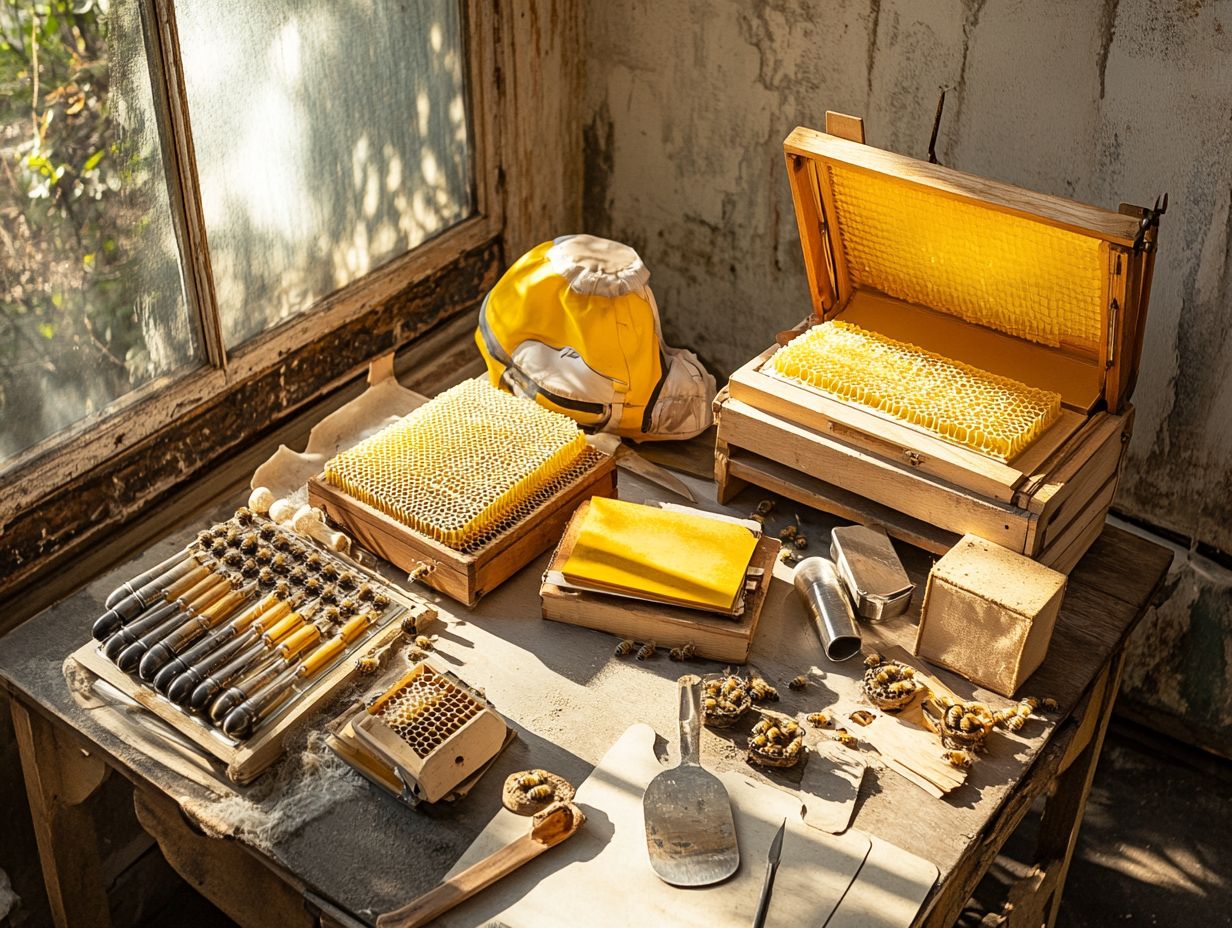
Material quality is a crucial consideration when selecting your beekeeping supplies. It profoundly influences the durability and effectiveness of your equipment.
When you invest in high-quality materials, such as sturdy cedar or cypress wood for your hives, you’re ensuring enhanced longevity and resistance to the elements. This foresight translates into robust colonies that thrive for years to come.
Opting for cheaper materials could lead to quicker deterioration, resulting in more frequent replacements and ultimately increasing your costs over time.
Moreover, protective clothing crafted from durable fabrics offers superior protection from stings and irritants while standing up to wear and tear, ensuring your safety while working with bees.
By prioritizing material integrity in your beekeeping supplies, you can safeguard your investment and foster a sustainable environment for your bees to flourish.
Start exploring your options today and gear up for beekeeping success!
2. Brand Reputation
Brand reputation is crucial when selecting quality beekeeping supplies, as trusted brands typically have a proven track record of delivering reliable and effective equipment.
Talking to local beekeepers and their networks can provide you with invaluable insights into which brands genuinely deliver on their promises. These community recommendations can heavily sway your purchasing decisions, as experienced beekeepers have firsthand knowledge of which products endure the test of time.
Renowned names in the industry, such as Dadant & Sons and Kelley Beekeeping, are esteemed for their unwavering commitment to quality and innovation. Their contributions have not only propelled advancements in beekeeping practices but have also established benchmarks that others aspire to achieve, ensuring you whether a novice or a seasoned beekeeper can find the necessary supplies to maintain thriving colonies.
3. Durability and Longevity
When you’re selecting beekeeping supplies, durability and longevity should be high on your list of priorities. These factors play a crucial role in determining how well your equipment can endure the demands of bee maintenance.
Investing in durable products means you re not just buying for today; you re securing a wise financial future. For example, high-quality wooden hives may come with a higher upfront cost compared to plastic options, but their longevity translates to fewer replacements and repairs over time.
Similarly, metal tools like hive tools and smokers typically outperform their plastic counterparts, retaining their functionality even with constant use. Evaluate the durability ratings of different equipment options to make informed choices that not only save you money but also boost your overall productivity in your beekeeping ventures.
4. Functionality and Ease of Use
When selecting beekeeping supplies, you must prioritize functionality and ease of use, as these elements are essential for effectively managing your hives.
Consider tools like hive tools and honey extractors that are thoughtfully designed with ergonomics the design of tools that fit comfortably in your hand in mind; they enable you to perform tasks with reduced strain and greater precision. For example, a well-crafted honey extractor can significantly alleviate shoulder strain during the extraction process, a crucial advantage during the bustling honey harvest season.
Incorporating features such as easy-grip handles or lightweight materials in your hive tools enhances your workflow, enabling you to concentrate on the health of your colonies instead of battling with cumbersome equipment. By choosing supplies that streamline your operations, you not only enhance your productivity but also elevate the overall pleasure and satisfaction of managing your apiary.
5. Cost-effective
Don’t miss out on finding great tools! Finding cost-effective solutions when selecting quality beekeeping supplies is crucial, whether you re a novice or an experienced beekeeper aiming to practice sustainable beekeeping.
By exploring a range of vendors and comparing prices, you can discover budget-friendly options that don t compromise on durability or efficiency. Investing in high-quality equipment enhances your performance and reduces the need for frequent replacements, ultimately saving you both money and resources.
Opting for sustainably produced supplies aligns with your broader environmental goals, supporting practices that contribute to the health of bee populations and ecosystems. This approach helps your beekeeping and the planet thrive. Whether you’re using vertical hives, horizontal hives, or traditional Langstroth frames a common type of beekeeping box each choice impacts the environment positively.
Where to Buy Quality Beekeeping Supplies?
When you re on the hunt for quality beekeeping supplies, you ll find excellent options at your fingertips, ranging from local beekeeping stores to online retailers. Local shops often provide a personalized shopping experience, where you can engage with knowledgeable staff and connect with fellow beekeepers. This enhances your understanding and passion for the craft.
On the other hand, online retailers bring the convenience of browsing a vast selection of products right from your home. You can find exactly what you need with ease.
Consider tapping into beekeeping associations and clubs, as they can be invaluable resources for purchasing supplies. This also supports your local beekeeping community. If budget constraints are a concern, don t overlook secondhand markets. You can discover quality equipment at more affordable prices.
In the world of beekeeping, there s something for everyone. With a little exploration, you can find the perfect supplies to suit your needs. Whether you are interested in honey production, backyard beekeeping, or the benefits of honey for homesteading, the right supplies can make all the difference.
1. Local Beekeeping Stores
Local beekeeping stores are ideal destinations for acquiring high-quality beekeeping supplies. They offer a curated selection of equipment specifically tailored to meet the needs of local beekeepers. From hive inspection tools to a reliable bee suit, these stores have everything you need for managing your bee colonies.
Beyond their impressive inventory, these shops excel in providing personalized service. You receive expert advice that enhances your beekeeping experience. This one-on-one interaction allows you to ask questions and gain valuable insights.
By supporting local businesses, you help foster a sense of community. Connecting with fellow beekeepers establishes lasting relationships. Engaging with knowledgeable staff and like-minded enthusiasts enables you to share insights, learn best practices, and deepen your understanding of the art of beekeeping. Whether you’re discussing techniques or learning about the latest in bee habitat management, these conversations can open doors to amazing insights!
2. Online Retailers
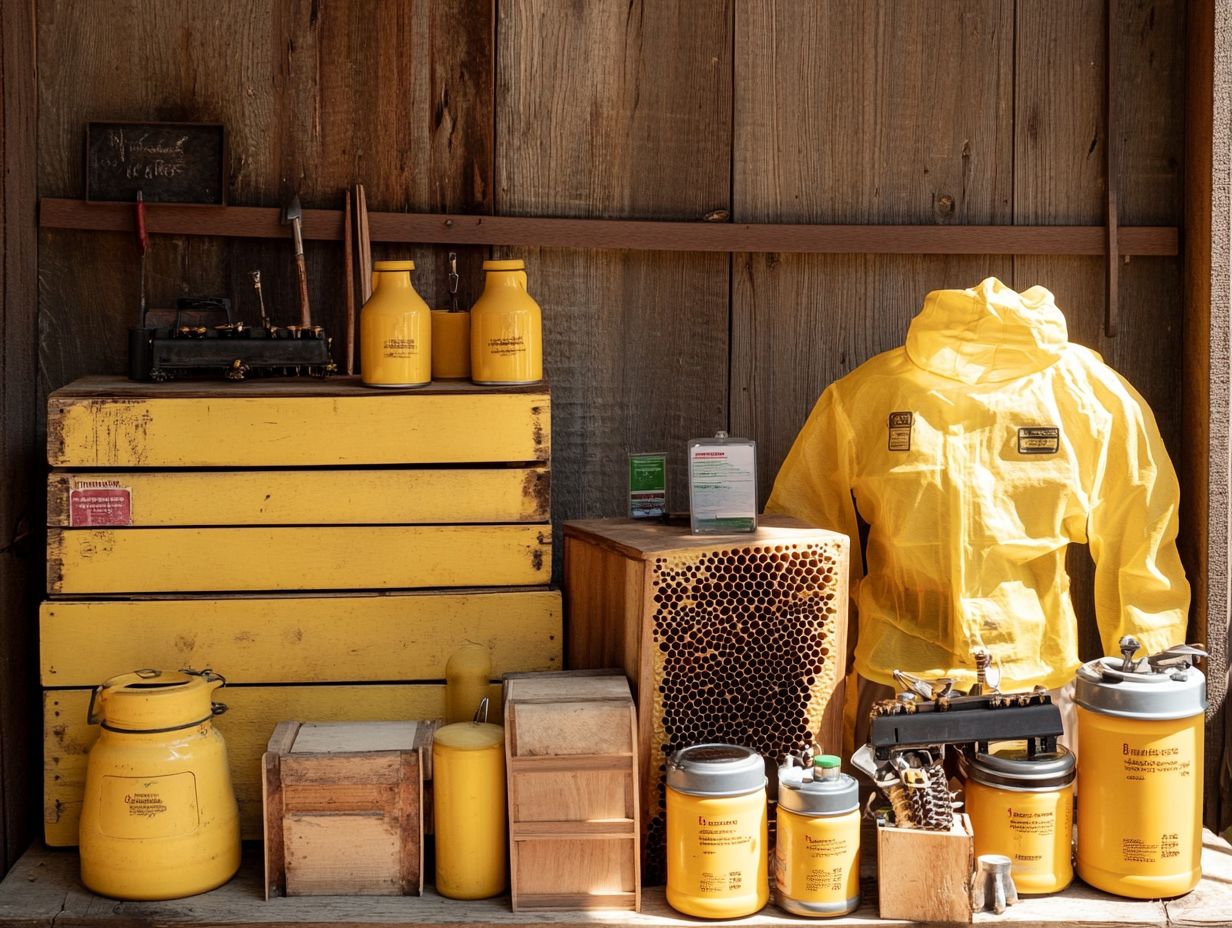
Online retailers have increasingly become your go-to destination for quality beekeeping supplies, thanks to their convenience and impressive variety. From hive bodies to extractor accessories, you can find everything you need with a few clicks.
This digital shopping experience not only offers access to an extensive range of products but also enables you to effortlessly compare prices across different platforms. This ensures you secure the best possible deals. Customer reviews provide insights and firsthand experiences from fellow beekeepers that can significantly shape your purchasing decisions. Act fast and grab the best deals before they run out!
However, it’s crucial to be mindful of potential drawbacks, such as shipping times that might delay the arrival of essential supplies. The lack of in-person support can also be a challenge when selecting the right equipment or addressing immediate concerns. Items like queen excluders and hive stands are best selected with expert advice to ensure they meet your specific needs.
Start your beekeeping journey now! Explore local stores and online options today!
3. Beekeeping Associations and Clubs
Beekeeping associations and clubs can serve as invaluable resources when you’re in the market for quality beekeeping supplies. They offer not just access to necessary equipment but also education and support tailored to your needs. Whether you’re learning about hive maintenance or the benefits of honey, these organizations have you covered.
These organizations play a pivotal role in bringing beekeepers together. They provide opportunities for members to take advantage of group buying discounts that can significantly lower the costs of essential items like hives, tools, and protective gear.
As a member, you’ll often find exclusive access to workshops, seminars, and training sessions designed to deepen your understanding of beekeeping practices. By joining a club, you can tap into a rich reservoir of shared knowledge and experience that fosters a community ripe for collaboration and mentorship.
This environment helps novice beekeepers refine their skills and enables seasoned beekeepers to exchange ideas and stay abreast of the latest industry trends.
4. Secondhand Markets
Explore secondhand markets for fantastic deals on beekeeping supplies! This is a savvy opportunity for you to acquire quality beekeeping supplies without straining your wallet, making it much easier for new beekeepers to dive into this rewarding hobby. It’s a great way to find essential tools like hive tools and bee gloves at a lower cost.
When buying used equipment, prioritize inspecting items thoroughly to ensure quality and safety. You often discover well-maintained items at a fraction of the cost of new ones. The perks might include access to hard-to-find treasures, like specific Layens frames or rare honey extractors. However, the risks could involve everything from equipment wear to possible contamination.
To ensure you re getting quality supplies, take the time to ask about their history and any prior use. It’s also essential to clean and sanitize secondhand supplies before introducing them to your apiary. This diligent approach helps maintain a healthy environment for your bees and protects them from any lingering diseases or pests. Items like honey supers and bee boxes should be inspected closely to ensure they are free from contamination.
Beekeeping experts like Adam Martin and Leslie Martin from Bee Kept in Culleoka, Tennessee, provide excellent resources for beginners and seasoned beekeepers alike. Their Bee Kept Bootcamp offers in-depth education on apiary management and sustainable beekeeping practices.
Frequently Asked Questions
Wondering what to look for in quality beekeeping supplies?
Some important factors to consider are the materials used, the reputation of the supplier, and any necessary certifications or approvals. Make sure to verify that the materials can withstand rigorous bee maintenance tasks, such as hive inspections and honey processing.
How can I tell if a beekeeping supply is made with high-quality materials?
Look for supplies made with durable materials such as stainless steel, high-density plastic, or food-grade wood. These materials are long-lasting and safe for beekeeping. For instance, a high-quality honey extractor made of stainless steel can significantly improve your honey production process.
Are there any certifications or approvals I should look for in beekeeping supplies?
Yes, look for supplies that are certified by reputable organizations such as the USDA or the National Honey Board. This ensures that the supplies meet certain standards of quality and safety. Items like a queen excluder or hive tool should meet these standards to ensure their reliability and durability.
Is it important to buy beekeeping supplies from a reputable supplier?
Yes, it is important to buy from a reputable supplier to ensure that you are getting high-quality, reliable supplies. Look for suppliers with positive reviews and a strong reputation in the beekeeping community. Reliable suppliers often offer essential tools like bee brushes and bee suits that are critical for safe and effective beekeeping.
What are some warning signs of low-quality beekeeping supplies?
Some warning signs include cheap or flimsy materials, lack of necessary certifications, and negative reviews from other beekeepers. Avoid supplies that do not have a proven track record for durability, especially for vital tools like honey extractors and hive stands.
Start browsing today to find amazing deals on the best equipment!
Can I Save Money by Purchasing Lower-Quality Beekeeping Supplies?
While it may seem tempting to save money by purchasing cheaper supplies, it can actually end up costing you more in the long run. Low-quality supplies may break or wear out quickly, leading to the need for frequent replacements. Investing in high-quality bee equipment, such as Langstroth frames or honey supers, ensures longevity and reliability in your beekeeping practices.

